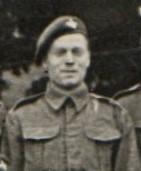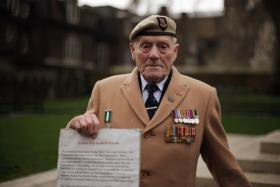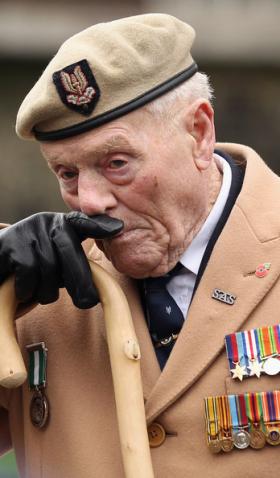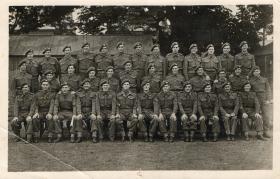George Edward Kay was born on the 8 May 1920, and came from Mosborough, near Sheffield, Derbyshire. He had been working as a transport driver before the war.
George Kay enlisted into The Sherwood Foresters on the 9 September 1938. [1]
Part of the Sherwood Foresters had been used to form Anti-Aircraft and Searchlight Regiments in the late 1930’s, and it was in one of these that George was serving when War was declared.
He served in a Heavy Anti-Aircraft Unit in France in 1940.
In early 1944 he volunteered for Airborne Forces, and after the selection process at Hardwick Hall, he was sent on parachute course 108, at RAF Ringway, 19 – 31 March 1944. This was a Long Course of eight descents consisting of, 2 x Day Balloon from 700 feet, 1 x Whitley A/C descent in pairs from 800 feet, 1 x Whitley A/C descent in fives from 700 feet, 1 x Whitely A/C descent in tens with container from 600 feet, 1 x Night Balloon descent, 1 x Douglas A/C descent in tens and 1 x Kitbag descent from Douglas A/C in sticks of 8. His Parachute Instructors comments: ‘Has shown progressive improvement on all descents’. [2]
He was initially posted to the Airborne Forces Holding Company, before then being assigned to the 3rd Parachute Battalion, then stationed at Spalding in Lincolnshire.
He served in 8 Platoon, C-Company, 3rd Parachute Battalion on Operation ‘MARKET’, and jumped onto DZ ‘X’ near Renkum in Holland on Sunday, 17 September 1944.
He was taken POW near Arnhem Bridge and sent to Stalag XIIA at Limburg in Germany, arriving there on the 27 September 1944 – here he was given the POW No. 88758. He was transported from there on the 5 October and arrived on the 14th October at Stalag XVIIIC at Markt-Pongau in Austria. [3]
He finally escaped, on the 24 April 1945,and made his way to Allied lines, “I escaped from XVIIIC on the 22/03/45, was recaptured 30km from Brenner Pass, near Innsbruck. I escaped again on the 24/04/45, was not recaptured”. [3]
He was discharged to the Section ‘B’ Reserve on the 23 October 1946. [1]
He re-enlisted, initially for one year, on the 11 December 1948. [1]
NOTES:
[1] The Parachute Regiment, Transfer & Enlistment Book 17, page 80.
[2] Parachute Course Report, RAF Ringway. March 1944.
[3] POW questionnaire. 1 June 1945.
The late George KAY, by Norman McKay.
It is with great sadness that I have to report the death of George Kay on Wednesday, 3 August 2011. He was 91 and had been suffering with cancer for some time. His funeral will be held at the HITHER GREEN CREMATORIUM, Verdant Lane, London. SE6 1TP, at 1245 hours on Tuesday, 23 August 2011.
George had a peerless record of service to this country. He jumped into Arnhem with C- Company, 3rd Battalion, The Parachute Regiment the on 17th September 1944. He was captured during the battle and escaped from the Germans just before the end of the War. He was one of the first volunteers to join the newly formed 21 SAS (Artists Rifles) early in 1947. He emigrated to Southern Rhodesia in the early 1960’s and fought in the war against the ANC - he was the Sgt Major of the Rhodesian Special Forces. He had to leave Rhodesia when the new Government was given power and moved with his family to South Africa. He joined the South African Army and finished up as WO1 in the 44th Parachute Brigade of the SADF.
When he returned to this country he became very involved with Action For Armed Forces where he was constantly a thorn in the side of successive Governments, managing to get as far as meetings with the Minister of Defence , that is when he wasn't chaining himself to the railings outside Buckingham Palace. He was well known to all the Policemen in the West End of London who always greeted him warmly.
George did not do ‘negative thoughts’ - he was badgering me to get him a tandem jump with the Red Devils even though he was seriously ill with the disease that killed him. REST IN PEACE George, you will be sadly missed by all your family, friends and admirers





Latest Comments
There are currently no comments for this content.
Add Comment
In order to add comments you must be registered with ParaData.
If you are currently a ParaData member please login.
If you are not currently a ParaData member but wish to get involved please register.